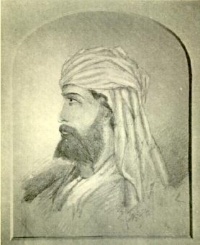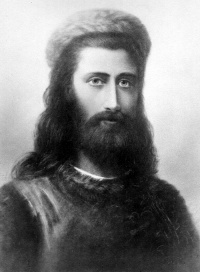Portraits of the Masters: Difference between revisions
Pablo Sender (talk | contribs) |
Pablo Sender (talk | contribs) No edit summary |
||
| Line 30: | Line 30: | ||
"Describe his looks and dress," called out H. P. B. And while those in the room were wondering over Madame Blavatsky’s exclamation, the woman addressed said: "He is about Mohini’s height; slight of build; wonderful face full of light and animation; flowing curly black hair, over which is worn a soft cap. He is a symphony in greys and blues. His dress is that of a Hindu - though it is far finer and richer than any I have ever seen before - and there is fur trimming about his costume. It is his picture that is being made, and he himself is guiding the work."<ref>[http://www.blavatskyarchives.com/holloway2.htm# The Portraits of the Mahatmas] at Blavatsky Study Center</ref></blockquote> | "Describe his looks and dress," called out H. P. B. And while those in the room were wondering over Madame Blavatsky’s exclamation, the woman addressed said: "He is about Mohini’s height; slight of build; wonderful face full of light and animation; flowing curly black hair, over which is worn a soft cap. He is a symphony in greys and blues. His dress is that of a Hindu - though it is far finer and richer than any I have ever seen before - and there is fur trimming about his costume. It is his picture that is being made, and he himself is guiding the work."<ref>[http://www.blavatskyarchives.com/holloway2.htm# The Portraits of the Mahatmas] at Blavatsky Study Center</ref></blockquote> | ||
== See also == | |||
*[[Masters of Wisdom]] | |||
*[[Adepts]] | |||
*[[Brotherhood of Adepts]] | |||
==Online resources== | ==Online resources== | ||
Revision as of 16:32, 8 July 2014
Portraits of Mahatma Morya
By Monsieur Harrisse
The first portrait of the Masters ever produced was done in black and white crayons by the French artist Monsieur Harrisse. The event took place on February 11, 1878, when the amateur artist was visiting the Founders at The "Lamasery" in New York. Col. Olcott writes:
One evening when the conversation turned upon India and Rajput bravery, H. P. B. whispered to me that she would try to get him to draw our Master’s portrait if I could supply the materials. There were none in the house, but I went to a shop close by and purchased a sheet of suitable paper and black and white crayons. The shopkeeper did up the parcel, handed it me across the counter, took the half-dollar coin I gave him, and I left the shop. On reaching home I unrolled my parcel and, as I finished doing it, the sum of half a dollar, in two silver pieces of a quarter-dollar each dropped on the floor! The Master, it will be seen, meant to give me his portrait without cost to myself.[1]
The production took place as follows:
Harrisse was then asked by H. P. B. to draw us the head of a Hindu chieftain, as he should conceive one might look. He said he had no clear idea in his mind to go upon, and wanted to sketch us something else; but to gratify my importunity went to drawing a Hindu head. H. P. B. motioned me to remain quiet at the other side of the room, and herself went and sat down near the artist and quietly smoked. From time to time she went softly behind him as if to watch the progress of his work, but did not speak until it was finished, say an hour later. I thankfully received it, had it framed, and hung it in my little bed-room. But a strange thing had happened. After we gave the picture a last glance as it lay before the artist, and while H. P. B. was taking it from him and handing it to me, the cryptograph signature of my Guru came upon the paper; thus affixing, as it were, his imprimatur upon, and largely enhancing the value of his gift.[2]
As to the likeness and method of production of the portrait, the Colonel wrote:
At that time I did not know if it resembled the Guru or not, as I had not yet seen him. When I did, later on, I found it a true likeness and, moreover, was presented by him with the turban which the amateur artist had drawn in the picture as his head-covering. Here was a genuine case of thought-transference, the transfer of the likeness of an absent person to the brain-consciousness of a perfect stranger. Was it or was it not passed through the thought of H. P. B.? I think so.[3]
Portraits of Mahatma Koot Hoomi
By Hermann Schmiechen
Mahatma M. wrote to H. P. Blavatsky:
Take her [Laura C. Holloway] with you to Schmiechen and tell her to see. Yes, she is good and pure and chela-like; only flabby in kindness of heart. Say to Schmiechen that he will be helped. I myself will guide his hands with brush for K[oothoomi]'s portrait.[4]
The presence of Master M. was confirmed by Mahatma K.H. himself in a letter to Mr. Sinnett that said:
I believe you are now satisfied with my portrait made by Herr Schmiechen and as dissatisfied with the one you have? Yet all are like in their way. Only while the others are the productions of chelas, the last one was painted with M.'s hand on the artist's head, and often on his arm.[5]
However, in an account by Laura C. Holloway it seems that finally it was the Master K.H. himself who helped the artist:
... saw the figure of a man outline itself beside the easel and, while the artist with head bent over his work continued his outlining, it stood by him without a sign or motion. She [the seer] leaned over to her friend and whispered: "It is the Master K. H.; he is being sketched. He is standing near Mr. Schmiechen." "Describe his looks and dress," called out H. P. B. And while those in the room were wondering over Madame Blavatsky’s exclamation, the woman addressed said: "He is about Mohini’s height; slight of build; wonderful face full of light and animation; flowing curly black hair, over which is worn a soft cap. He is a symphony in greys and blues. His dress is that of a Hindu - though it is far finer and richer than any I have ever seen before - and there is fur trimming about his costume. It is his picture that is being made, and he himself is guiding the work."[6]
See also
Online resources
Articles
- The Portraits of the Mahatmas at Blavatsky Study Center
Notes
- ↑ Henry Steel Olcott, Old Diary Leaves First Series (Adyar, Madras: The Theosophical Publishing House, 1974), 370-371.
- ↑ Henry Steel Olcott, Old Diary Leaves First Series (Adyar, Madras: The Theosophical Publishing House, 1974), 371.
- ↑ Henry Steel Olcott, Old Diary Leaves First Series (Adyar, Madras: The Theosophical Publishing House, 1974), 371-372.
- ↑ The Portraits of the Mahatmas at Blavatsky Study Center
- ↑ Vicente Hao Chin, Jr., The Mahatma Letters to A.P. Sinnett in chronological sequence No. 129 (Quezon City: Theosophical Publishing House, 1993), ???.
- ↑ The Portraits of the Mahatmas at Blavatsky Study Center

